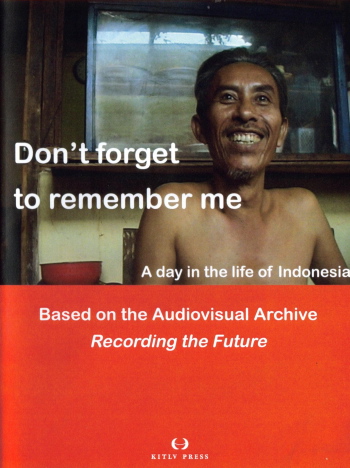Andy Fuller
Inspired by Michael Apted’s Up television documentary series, which follows British children from different socio-economic backgrounds from the age of seven and meets up with them again every seven years thereafter, in 2003 the KITLV in Leiden embarked on its Recording the Future project in Indonesia. Instead of focusing on the lives of individuals, this project uses places – cities, villages, street corners – as its main characters. A film, Don’t Forget to Remember Me (2007) is the first made up of footage from this highly significant ‘work-in-progress’ archive.
Directed by Henk Schulte Nordholt and Fridus Steijlen, this large archival project documents audio-visual and sound material collected from seven locations throughout Indonesia: Jakarta, Kawal (Bintan), Payakumbuh (West Sumatra), Delanggu (Central Java), Sintang (West Kalimantan), Bittuang (Central Sulawesi), Ternate (Eastern Indonesia) and Surabaya (East Java). Every year, the crew visit two places and record for a period of ten days collecting around 20-25 hours of recordings. After four years, and recording in eight locations, they then return to the first location and on it goes in this four year cycle. This is not a modest project. Over the next 100 years, they aim to collect up to 5000 hours of footage. The film Don’t Forget to Remember Me presents fragments of material already gathered and so serves as a kind of introduction to the project’s aims and framework.
Daily life
The archives and the film document everyday life in Indonesia. Some of the scenes in Don’t Forget to Remember Me include men playing a board game in a river-side kampung in Jakarta, bus drivers at a terminal in Surabaya complaining about the number of motorcycles and the manner in which mobile phones are used, fishing for stingray in Sulawesi, raising a national flag at a primary school, young children learning to recite the Qur’an, and school boys playing soccer in an empty field. Throughout the film, there are scenes of the inculcation of a sense of nation, the teaching of religious practice, negotiating technologies of communication and transport, the intersection of the global with the local and the networks of support amongst local communities.
The street is one of the primary sites of the film. A lone motorcyclist drives down a main street of Kawal (Bintan) at 5am, while in Jakarta half an hour later, a busy intersection shows a complex array of activity. In this scene, buses, bajajs, mini-buses and motorcycles are already passing steadily through the intersection. Only sometimes do users of this street pay attention to the colour of the traffic lights which try in vain to assert their authority. A motorcycle-taxi driver awaits his first passenger, a uniformed street cleaner sweeps the side of the road. The buses gently sound their horns to attract potential passengers and warn off other vehicles. There are no lines marking the lanes on the intersection, and one pedestrian walks slowly across the road, perhaps after finishing a morning run.
Visual anthropology
Don’t Forget to Remember Me is similar, in some senses, to Vincent Mmonnikendam’s Mother Dao the Turtle Like (1995) – a film based on Dutch archival footage from the early twentieth century. In comparision to Mother Dao, however, Don’t Forget has a stronger narrative structure, plan and consistency in filming style. Where Monnikendam’s film draws on archival material, Nordholt and Steijlen’s project is about creating an archive. The aim of the project is to create new sources and analytical methods for understanding Indonesian histories. This is an archive in which ‘the everyday life of (mostly) ordinary Indonesians is central’.
Don’t Forget to Remember Me also relates to the practices of Jean Rouch, a French film maker who is generally regarded as the pioneer of using film as a medium for anthropological inquiry. One of the telling features of the film is the manner in which the camera functions. The camera is present throughout the film; viewers are made constantly aware of its subjectivity; its gaze, its act of looking. The camera moves in a self- reflexive and self-aware manner, functioning as a player within the scenes it seeks to capture and it interacts with those who the camera (and cameraman, whom we hear him talking) follows with its lens.
There is little narration in the film. Indeed, it is the camera that assumes the role of narrator. The cameraman, however, does provide a degree of involvement through his asking of questions to those he films. The roaming, inquisitive camerawork by Lexy Rambadeta is generally enticing and curious. However his questions provide some awkward moments. These include when workers who seem oblivious to his filming, are then disturbed by his questions and become self-conscious. A scene where he questions fans of Kurt Cobain about Cobain’s life comes across as being a test of their knowledge and appears somewhat condescending. Here are teenagers making a statement about what interests them and how they imagine their identities. The pop culture of 1990s USA is easily absorbed, appropriated and consumed in Indonesia.
Throughout the film there is material which lends itself to a vast array of subjects studied within Asian studies and specifically Indonesian studies. Don’t Forget to Remember Me presents a multi-dimensional introduction to everyday life in Indonesia. Viewers are invited to make their own conclusions based on comparisons between how everyday life is practiced in the different spaces and places in the film. This representation of Indonesian realities shows a history that is ongoing, contingent and that is performed by a diverse assortment of actors – each determining and creating their own strategies for negotiating change in urban and or rural environments.
Henk Schulte Nordholt and Fridus Steijlen (eds), Don't forget to remember me: A day in the life in Indonesia, Leiden: KITLV, 2008.
Andy Fuller (fuller.andy@gmail.com) has recently finished his PhD at the University of Tasmania, Australia. His research focuses on the intersection of urban and literary cultures in Indonesia. The You Tube channel for the Recording the Future can be found at (www.youtube.com/user/kitlvrtf).
